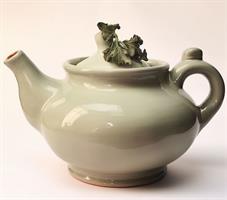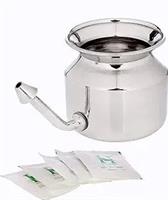Are you tired of sleepless nights due to snoring? You might be surprised to find out that a simple device like a neti pot could help improve your sleep quality.
Does a neti pot help snoring? Neti pots are often used as a natural remedy for allergies, sinus problems, and nasal congestion, but they can also be effective in reducing snoring.
In this article, we will explore the connection between neti pots and snoring, discussing how they work, their benefits, and how to combine them with other anti-snoring solutions for maximal effectiveness.
Get ready to delve into the world of neti pots and how they can help you achieve a quieter and more restful night’s sleep. Not only will you learn how to use a neti pot safely and effectively, but you’ll also discover how to select the best neti pot for your needs and the potential side effects and precautions to consider.
Key Takeaways
-
Neti pots are a drug-free device used to reduce snoring and improve sleep quality by flushing out irritants with saline solution.
-
Combining neti pot use with other anti-snoring solutions, such as snoring mouthpieces, can offer an even more comprehensive approach to reducing snoring.
-
Safe and effective usage requires choosing the right water source, preparing the correct saline solution concentration, proper technique and frequency of use for a neti pot. Consulting medical advice is recommended before combining devices.
Neti Pot and Snoring: The Connection
Neti pots are a popular solution for nasal irrigation, which involves flushing out the nasal cavity and sinuses to remove obstructions and improve respiration. They may also help reduce snoring by clearing nasal passages and promoting healthier breathing, making them a useful tool for those with congestion-related snoring.
In fact, neti pots can even benefit individuals with obstructive sleep apnea by restoring the inner lining of the nose to a healthier, less irritated condition.
Neti pots alleviate nasal congestion, a common cause of snoring, by flushing out irritants and thinning mucus, thus improving airflow and reducing blockages that can lead to snoring. This makes them an effective natural remedy for those who snore due to sinus problems, allergies, or the common cold.
How Neti Pots Work
Neti pots are small teapot-like devices filled with a saline solution, designed to flush out irritants and thin mucus in the nasal passages. The process of nasal irrigation involves pouring the saline solution into one nostril, allowing it to flow through the nasal cavity and exit the other nostril. This helps to clear congestion, improve airflow, and reduce any blockages that can lead to snoring.
Many neti pot users report improved breathing and reduced snoring as a result of regular use. The saline solution used in neti pots is gentle on the nasal passages, making it a more natural alternative to medicated nasal sprays.
Plus, neti pots are a drug-free solution, which means they can be used without the risk of side effects or dependency often associated with over-the-counter nasal sprays.
Benefits for Snorers
Snorers can greatly benefit from using a neti pot, as it can help reduce congestion and enhance breathing, resulting in a quieter sleep. Some individuals may also find relief by using nasal sprays or nasal strips in conjunction with a neti pot for additional support in clearing nasal passages.
By addressing both nasal congestion and airway obstruction, a neti pot can effectively decrease snoring and improve overall sleep quality.
In addition to its benefits for snorers, neti pots can also help those with sinus problems, allergies, or the common cold by flushing out irritants and thinning mucus. This can lead to fewer headaches, facial pain, and other symptoms associated with nasal congestion. So whether you’re suffering from snoring or simply looking for relief from seasonal allergies, a neti pot might just be the solution you need.
Combining Neti Pot with Other Anti-Snoring Solutions
While neti pots can be effective in reducing snoring on their own, combining them with other anti-snoring solutions can further enhance the effectiveness of both treatments.
For example, using a neti pot alongside a snoring mouthpiece can address both nasal congestion and airway obstruction, potentially offering a more comprehensive approach to reducing snoring and improving sleep quality.
In the following sections, we will explore:
-
Snoring mouthpieces
-
How to integrate them with neti pot use
-
Guidance on selecting the best neti pot for your needs
-
Ensuring safe and effective usage
-
Addressing potential side effects and precautions
Snoring Mouthpieces
Snoring mouthpieces work by repositioning the jaw or tongue to open the airway, facilitating greater airflow through the airway and reducing or eliminating snoring. These devices are worn in the mouth during sleep and come in various types, such as mandibular advancement devices and tongue stabilizing devices.
Using a neti pot in combination with a snoring mouthpiece can help ensure clear nasal passages, thus potentially increasing the effectiveness of both devices in reducing or eliminating snoring. By addressing both the nasal congestion and airway obstruction aspects of snoring, this combination can offer a more comprehensive solution for those seeking a quieter and more restful night’s sleep.
Integrating Neti Pot and Mouthpiece Use
For optimal results when integrating neti pot use with a snoring mouthpiece, consider using the neti pot before the mouthpiece, or vice versa. By clearing nasal passages with the neti pot first, you can ensure that the snoring mouthpiece can work more effectively in reducing airway obstruction.
It’s important to be aware of potential side effects and precautions when combining a neti pot with a snoring mouthpiece, such as irritation of the nasal passages, sinus infections, and allergic reactions. Therefore, it is highly recommended to seek medical advice prior to using these devices together.
Safe and Effective Neti Pot Usage
Following the proper guidelines is crucial for safe and effective neti pot usage. This includes choosing the right water, preparing the saline solution correctly, and adhering to the recommended technique and frequency.
By following these guidelines, you can minimize the risk of infection and ensure that you get the most benefits out of your neti pot use.
In this section, we will discuss:
-
The importance of selecting the right water for your neti pot
-
How to prepare the saline solution
-
The proper technique and frequency for using a neti pot
By following these recommendations, you can enjoy the benefits of neti pot use while minimizing potential risks.
Choosing the Right Water
Safe water choices for neti pot use include distilled, sterile, or previously boiled water to avoid introducing harmful bacteria. Using tap water that has not been filtered, treated, or processed can lead to serious infections and should be avoided. If you choose to use filtered water, make sure the filter’s specifications can effectively remove bacteria and other contaminants.
Using appropriate water sources for your neti pot is crucial to avoid serious, potentially life-threatening infections like primary amebic meningoencephalitis (PAM) caused by the Naegleria fowleri bacteria. By using safe water sources, such as distilled, sterile, or previously boiled water, you can greatly reduce the risk of infection and enjoy the benefits of neti pot use worry-free.
Preparing the Saline Solution
Preparing the saline solution for your neti pot involves:
-
Mixing non-iodized salt and baking soda, which helps break down excess mucus in the nasal passages.
-
Adding between one-fourth and one-half of a teaspoon of salt for every eight ounces of water. This ensures that the water has the optimal salinity level.
-
Using a pure salt, rather than standard table salt, is recommended to ensure the solution is gentle on your nasal passages.
When creating the saline solution, make sure to use water that is at a lukewarm temperature, as this can help to avoid discomfort during the nasal irrigation process.
By preparing the saline solution correctly, you can ensure the neti pot is as effective as possible in clearing your nasal passages and reducing snoring.
Proper Technique and Frequency
The correct technique for using a neti pot involves pouring the saline solution into one nostril and allowing it to flow out the other nostril, with usage instructions varying depending on individual requirements. To ensure safe and effective use, it is important to establish a reasonably tight seal on the nostril and not to exceed usage of once a day.
The frequency for utilizing a neti pot may vary depending on individual needs, but it is generally recommended to use the neti pot no more than once a day. If you experience any side effects or concerns, consult your healthcare professional for guidance on the appropriate frequency and technique for your specific situation.
Selecting the Best Neti Pot for Your Needs
Consider material options, design and comfort factors, and ease of cleaning and maintenance when selecting a neti pot to find the best fit for your needs. By taking the time to research and compare different neti pots, you can ensure that you’re choosing the right device to help reduce snoring and improve your overall sleep quality.
In this section, we will discuss the various material options for neti pots, the design and comfort considerations to keep in mind, and the importance of proper cleaning and maintenance. By understanding these factors, you can make an informed decision when selecting the best neti pot for your needs.

Material Options
Neti pots are available in various materials, each with their own advantages and disadvantages. Here are the different types of neti pots and their characteristics:
-
Plastic neti pots: Lightweight, sturdy, and cost-effective. However, they may not be as long-lasting as other materials.
-
Ceramic neti pots: More resilient than plastic, but they are weightier and pricier.
-
Glass neti pots: Boast a high degree of durability and ease of cleaning. However, they come with a higher price tag and may be prone to breakage.
-
Stainless steel neti pots: Offer enhanced durability and ease of cleaning. However, they are typically more costly and may be challenging to use.
When selecting a material for your neti pot, consider factors such as durability, ease of cleaning, and cost. By evaluating these factors, you can choose a neti pot that best suits your needs and preferences.
Design and Comfort Considerations
Design and comfort considerations when selecting a neti pot include:
-
The shape
-
The size
-
The ease of use
-
Personal preferences
Some neti pots feature a long spout for effective rinsing, while others have a more ergonomic design for comfortable use. It’s important to choose a neti pot that will be easy for you to use regularly and that fits comfortably in your hand.
In addition to design and comfort factors, consider how easy the neti pot will be to clean and maintain. A design with a simple shape and wide opening, as well as the absence of intricate nooks or cavities within the handle, is recommended for easy cleaning. By selecting a neti pot with a design that prioritizes comfort and ease of use, you can ensure a more enjoyable and effective nasal irrigation experience.
Cleaning and Maintenance
Proper cleaning and maintenance of your neti pot are crucial to prevent bacterial buildup and ensure safe, hygienic use. It is recommended to clean the neti pot after each use with warm, soapy water and allow it to air dry.
Following these cleaning and maintenance guidelines will not only prolong the life of your neti pot but will also ensure that you’re using it safely and effectively.
By keeping your neti pot clean and well-maintained, you can enjoy the benefits of nasal irrigation without worrying about potential infections or other risks.
Potential Side Effects and Precautions
While neti pots offer numerous benefits for those suffering from snoring and nasal congestion, being aware of potential side effects and precautions is important when using them.
Using a neti pot can cause various side effects, including:
-
Nasal irritation
-
Nosebleeds
-
Headaches
-
Fever
-
A burning or stinging sensation in the nose
If any of these symptoms persist, it is important to monitor and address them accordingly.
Be sure to follow all guidelines for safe neti pot use, including using safe water sources, proper cleaning, and consulting a physician if you have concerns or experience persistent side effects. By taking these precautions, you can minimize the risks associated with neti pot use and enjoy the many benefits they have to offer.
These side effects are generally mild and temporary, but if they persist or worsen, it’s important to consult your healthcare professional for guidance.
It’s also worth noting that some people may be more prone to experiencing side effects from neti pot use, such as those with allergies or a history of sinus infections. In these cases, it’s especially important to consult a healthcare professional before using a neti pot to ensure that it’s safe and appropriate for your specific needs.
Precautions and Consultation
To ensure safe neti pot use and minimize the risk of side effects, follow all recommended guidelines, including using safe water sources such as distilled, sterile, or previously boiled water, and maintaining proper cleaning of your neti pot. If you have any concerns about using a neti pot or experience persistent side effects, it’s important to consult your healthcare professional for advice and guidance.
By taking the necessary precautions and following proper neti pot usage guidelines, you can enjoy the benefits of nasal irrigation while minimizing potential risks.
Remember that each individual’s experience with neti pots may vary, so it’s crucial to monitor your own response and consult a healthcare professional as needed.
Summary
In conclusion, neti pots can be an effective solution for snoring and nasal congestion, offering numerous benefits for those who struggle with these issues. By combining neti pot use with other anti-snoring solutions, such as snoring mouthpieces, you can potentially increase the efficacy of both treatments in diminishing snoring and improving sleep quality.
It’s crucial to follow the proper guidelines for safe and effective neti pot use, including using safe water sources, preparing the saline solution correctly, and adhering to the recommended technique and frequency.
By selecting the best neti pot for your needs, ensuring proper cleaning and maintenance, and being aware of potential side effects and precautions, you can enjoy a more restful night’s sleep and improve your overall well-being.
So, why not give a neti pot a try and see if it can help you breathe easier and snore less?
Frequently Asked Questions
How do I unclog my nose to stop snoring?
Open your nasal passages with the help of nasal strips or a hot shower before bed, rinse your nose with saltwater, and avoid alcohol consumption to reduce snoring.
Can a neti pot help with sleep apnea?
Using a neti pot may help to reduce nasal congestion and therefore offer some relief from snoring, but there is no evidence that it can provide a cure for sleep apnea. It is important to note that a CPAP machine is the most effective treatment for sleep apnea.
How do I clear my throat of mucus to stop snoring?
Avoid consuming sedatives or alcohol before bed, and use nasal strips or a mandibular advancement device to promote smoother mouth breathing. To reduce congestion, try peppermint oil or goldenseal as natural remedies for relieving sore throats and clearing mucus in the nasal passageways.
How do neti pots help reduce snoring?
Neti pots can be used to clear nasal passages and promote healthier breathing, making them an effective way to reduce congestion-related snoring.
What is the proper technique for using a neti pot?
To properly use a neti pot, pour the saline solution into one nostril and allow it to flow out the other nostril.
References
- A multicenter survey on the effectiveness of nasal irrigation devices in rhinosinusitis patients. https://www.ncbi.nlm.nih.gov/pmc/articles/PMC7752074/
- Nasal Irrigation & Snoring. https://www.intushealthcare.com/help-and-advice/nasal-irrigation/conditions-treated/snoring/







